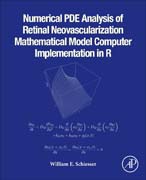
Numerical PDE Analysis of Retinal Neovascularization Mathematical Model Computer Implementation in R
Schiesser, William E.
Numerical PDE Analysis of Retinal Neovascularization Mathematical Model Computer Implementation in R provides a methodology for the analysis of neovascularization (formation of blood capillaries) in the retina. The starting point is a system of three partial differential equations (PDEs) that define the evolution of (1) capillary tip density, (2) blood capillary density and (3) concentration of vascular endothelial growth factor (VEGF) in the retina as a function of space (distance along the retina), x, and time, t. The three PDE dependent variables for (1), (2) and (3), designated as u1(x, t), u2(x, t), u3(x, t), respectively, result from the numerical integration (solution) of the three PDEs. Homogeneous (zero) initial conditions (ICs) and homogeneous Neumann boundary conditions are specified, but these can easily be changed in the R routines that implement the PDEs, ICs and BCs (the programming is in R, a quality, open-source scientific computing system). Initially, the model dependent variables move away from the homogeneous ICs in response to a source term for VEGF in the PDE for u3(x, t). This three PDE model is used to demonstrate the coding and execution of the R routines. The basic numerical algorithm is the method of lines (MOL), a procedure for converting PDEs to systems of approximating ordinary differential equations (ODEs). The latter can then be integrated (solved) numerically with an R library initial-value ODE integrator. Then the model is extended to four PDEs through the addition of a PDE for oxygen concentration, designated u4(x, t). The model moves away from the homogeneous ICs for u1, u2, u3 in response to a depletion term in the u4(x, t) PDE that represents developing hypoxia (oxygen deficiency) in the retina. The IC for u4 is a uniform, normal (healthy) level of oxygen and the u4 PDE gives the drop in oxygen concentration from the IC that leads to VEGF production. Finally, the four PDE model is extended to include the delivery of a therapeutic anti- VEGF drug represented as a source term in the u3(x, t) PDE. The anti-VEGF drug delivery term can be varied as a function of t to represent the scheduled application of the drug therapy, for example, through one injection or repeated injections. The book develops a methodology that can be used to study retinal vascularization. The author intends this to provide a small step toward a better understanding and treatment of conditions such as prenatal neovascularization, diabetic retinopathy and age-related macular degeneration (AMD). Includes PDE routines based on the method of lines (MOL) for computer-based implementation of PDE models Offers transportable computer source codes for readers in R, with line-by-line code descriptions as it relates to the mathematical model and algorithmsAuthored by a leading researcher and educator in PDE models INDICE: 1. Basic three PDE formulation 2. Computer implementation 3. Variation of parameters 4. Detailed PDE analysis 5. Oxygen effect 6. Anti-VEGF drug therapy
- ISBN: 978-0-12-818452-3
- Editorial: Academic Press
- Encuadernacion: Rústica
- Páginas: 232
- Fecha Publicación: 01/07/2019
- Nº Volúmenes: 1
- Idioma: Inglés
